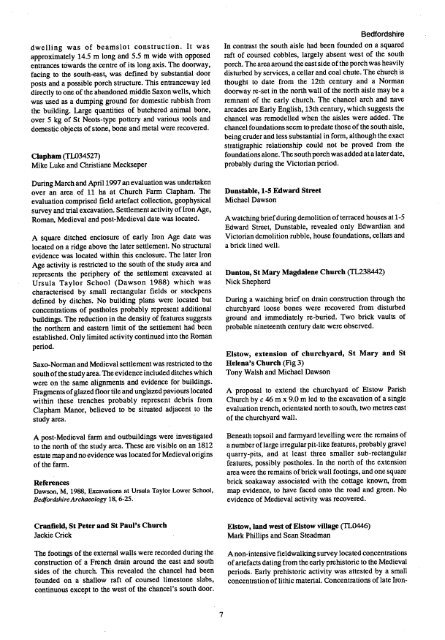CBA SMA\SMA 1998.PDF - Council for British Archaeology
CBA SMA\SMA 1998.PDF - Council for British Archaeology
CBA SMA\SMA 1998.PDF - Council for British Archaeology
Create successful ePaper yourself
Turn your PDF publications into a flip-book with our unique Google optimized e-Paper software.
dwelling was of beamslot construction. It was<br />
approximately 14.5 m long and 5.5 m wide with opposed<br />
entrances towards the centre of its long axis. The doorway,<br />
facing to the south-east, was defined by substantial door<br />
posts and a possible porch structure. This entranceway led<br />
directly to one of the abandoned middle Saxon wells, which<br />
was used as a dumping ground <strong>for</strong> domestic rubbish from<br />
the building. Large quantities of butchered animal bone,<br />
over 5 kg of St Neots-type pottery and various tools and<br />
domestic objects of stone, bone and metal were recovered.<br />
Clapham (TL034527)<br />
Mike Luke and Christiane Mecicseper<br />
During March and Apri11997 an evaluation was undertaken<br />
over an area of 11 ha at Church Farm Clapham. The<br />
evaluation comprised field artefact collection, geophysical<br />
survey and trial excavation. Settlement activity of Iron Age,<br />
Roman, Medieval and post-Medieval date was located.<br />
A square ditched enclosure of early Iron Age date was<br />
located on a ridge above the later settlement. No structural<br />
evidence was located within this enclosure. The later Iron<br />
Age activity is restricted to the south of the study area and<br />
represents the periphery of the settlement excavated at<br />
Ursula Taylor School (Dawson 1988) which was<br />
characterised by small rectangular fields or stockpens<br />
defined by ditches. No building plans were located but<br />
concentrations of postholes probably represent additional<br />
buildings. The reduction in the density of features suggests<br />
the northern and eastern limit of the settlement had been<br />
established. Only limited activity continued into the Roman<br />
period.<br />
Saxo-Norman and Medieval settlement was restricted to the<br />
south of the study area. The evidence included ditches which<br />
were on the same aligments and evidence <strong>for</strong> buildings.<br />
Fragments of glazed floor tile and unglazed paviours located<br />
within these trenches probably represent debris from<br />
Clapham Manor, believed to be situated adjacent to the<br />
study area.<br />
A post-Medieval farm and outbuildings were investigated<br />
to the north of the study area. These are visible on an 1812<br />
estate map and no evidence was located <strong>for</strong> Medieval origins<br />
of the farm.<br />
References<br />
Dawson, M, 1988, Excavations at Ursula Taylor Lower School,<br />
Bed<strong>for</strong>dshire <strong>Archaeology</strong> 18, 6-25.<br />
Bed<strong>for</strong>dshire<br />
In contrast the south aisle had been founded on a squared<br />
raft of coursed cobbles, largely absent west of the south<br />
porch. The area around the east side of the porch was heavily<br />
disturbed by services, a cellar and coal chute. The church is<br />
thought to date from the 12th century and a Norman<br />
doorway re-set in the north wall of the north aisle may be a<br />
remnant of the early church. The chancel arch and nave<br />
arcades are Early English, 13th century, which suggests the<br />
chancel was remodelled when the aisles were added. The<br />
chancel foundations seem to predate those of the south aisle,<br />
being cruder and less substantial in <strong>for</strong>m, although the exact<br />
stratigraphic relationship could not be proved from the<br />
foundations alone. The south porch was added at a later date,<br />
probably during the Victorian period.<br />
Dunstable, 1-5 Edward Street<br />
Michael Dawson<br />
A watching brief during demolition of terraced houses at 1-5<br />
Edward Street, Dunstable, revealed only Edwardian and<br />
Victorian demolition rubble, house foundations, cellars and<br />
a brick lined well.<br />
Dunton, St Mary Magdalene Church (TL238442)<br />
Nick Shepherd<br />
During a watching brief on drain construction through the<br />
churchyard loose bones were recovered from disturbed<br />
ground and immediately re-buried. Two brick vaults of<br />
probable nineteenth century date were observed.<br />
Elstow, extension of churchyard, St Mary and St<br />
Helena's Church (Fig 3)<br />
Tony Walsh and Michael Dawson<br />
A proposal to extend the churchyard of Elstow Parish<br />
Church by c 46 m x 9.0 m led to the excavation of a single<br />
evaluation trench, orientated north to south, two metres east<br />
of the churchyard wall.<br />
Beneath topsoil and farmyard levelling were the remains of<br />
a number of large irregular pit-like features, probably gravel<br />
quarry-pits, and at least three smaller sub-rectangular<br />
features, possibly postholes. In the north of the extension<br />
area were the remains of brick wall footings, and one square<br />
brick soakaway associated with the cottage known, from<br />
map evidence, to have faced onto the road and green. No<br />
evidence of Medieval activity was recovered.<br />
Cranfield, St Peter and St Paul's Church<br />
Jackie Crick<br />
The footings of the external walls were recorded during the<br />
construction of a French drain around the east and south<br />
sides of the church. This revealed the chancel had been<br />
founded on a shallow raft of coursed limestone slabs,<br />
continuous except to the west of the chancel's south door.<br />
Elstow, land west of Elstow village (TL0446)<br />
Mark Phillips and Sean Steadman<br />
A non-intensive fieldwal king survey located concentrations<br />
of artefacts dating from the early prehistoric to the Medieval<br />
periods. Early prehistoric activity was attested by a small<br />
concentration of lithic material. Concentrations of late Iron-<br />
7

















